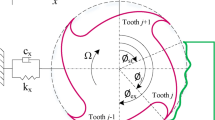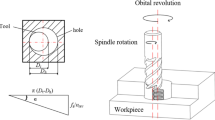Abstract
In order to enhance the manufacturing productivity, mobile machining with industrial robots is proposed as a cost-effective and portable manufacturing alternative to large-scale CNC machine tools in aircraft part machining. Combing the advantages of helical milling and parallel robot, the cutting forces and chatter stability of a novel 5-DOF hybrid PKM (named TriMule)-based helical milling process are first investigated in this paper. The cutting force and dynamic model of PKM-based helical milling operation are proposed, and the chatter stability diagrams at the seven representative machining positions are obtained based on the complete discretization scheme with Euler’s method approach. The predicted cutting forces and chatter stability diagrams are experimentally validated by the PKM-based titanium alloy helical milling. It can be found that the PKM machining position has a great influence on the corresponding limit stable axial depth of cut in the helical milling operation. Meanwhile, it was indicated that the spindle speed is an important factor affecting the helical milling stability difference at different machining positions. Meanwhile, it was found that the helical milling stability is only determined by second-, third-, and fourth-order modes of TriMule when the spindle speed is higher than 1000 rpm with the first 4 modes of the cutting system considered. The research results are expected to provide a basis for the helical milling parameter optimization and reasonable robot machining position selection.





















Similar content being viewed by others
Abbreviations
- Fx, Fy, Fz :
-
Cutting forces applied by the end effector
- kx, ky, kz :
-
Stiffness of PKM end effector along the direction of cutting forces
- F :
-
Cutting force caused by the peripheral cutting edges
- F f :
-
Cutting force caused by the front cutting edges
- h(θi):
-
Undeformed thickness of cutting chip of the tooth i
- db :
-
Differential width of cut
- dS i :
-
Differential edge length
- Fa, Fr, Ft :
-
Cutting forces in the directions of axial, radial, and tangential
- Krc, Ktc, Kac :
-
Cutting force coefficients associated with the thickness of cutting chips which are named shear effect coefficients for the radial, tangential, and axial direction
- Kre, Kte,Kae :
-
Independent of the thickness of cutting chips which are named the friction (or plowing) effect coefficients for the radial, tangential, and axial direction
- θ i :
-
Instantaneous immersion angle
- θ P :
-
Pith angle of the tool
- φ(z):
-
Lag angle for a particular disk
- β :
-
Helix angle of cutting tool
- R t :
-
Radius of cutting tool
- α :
-
Ramp angle
- g(ϕi):
-
Special function to indicate whether the tooth i is cutting or not
- r :
-
Tool runout
- λ :
-
Runout angle
- m, c , k :
-
Mass, damping ratio, and stiffness of PKM-tool system along xw and yw
- x,\( \dot{x} \),\( \ddot{x} \) :
-
Displacement, velocity, and acceleration of the tool in the direction of xw
- y,\( \dot{y} \),\( \ddot{y} \) :
-
Displacement, velocity, and acceleration of the tool in the direction of yw
- Fx(t),Fv(t) :
-
Cutting forces along the xw and yw
- Δx , Δy :
-
Regenerative vibration terms during the present and the previous tooth period in the xw and yw directions
- T :
-
Tooth period
- ξ :
-
Relative damping ratio
- ω n :
-
Angle natural frequency
- w :
-
Cutting depth
- m t :
-
Modal mass
- τ :
-
Time delay
- hxx(t), hxy(t), hyx(t),hyy(t) :
-
Specific cutting coefficients of 2-DOF
- τ :
-
Time delay between two successive teeth of helical milling
- n c :
-
Revolution speed
- n :
-
Spindle speed
- a :
-
Interpolation proportion parameter
- C k :
-
Coefficient matrix
- Φ :
-
Eigenvalues of transition matrix
References
Pereira RBD, Brandão LC, de Paiva AP, Ferreira JR, Davim JP (2017) A review of helical milling process. Int J Mach Tools Manuf 120:27–48. https://doi.org/10.1016/j.ijmachtools.2017.05.002
Ramulu M, Branson T, Kim D (2001) A study on the drilling of composite and titanium stacks. Compos Struct 54(1):67–77
Eguti CCA, Trabasso LG (2014) Design of a robotic orbital driller for assembling aircraft structures. Mechatronics 24(5):533–545. https://doi.org/10.1016/j.mechatronics.2014.06.007
Ji C, Li Y, Qin X, Zhao Q, Sun D, Jin Y (2015) 3D FEM simulation of helical milling hole process for titanium alloy Ti-6Al-4V. Int J Adv Manuf Technol 81(9-12):1733–1742. https://doi.org/10.1007/s00170-015-7323-8
Kim D, Sturtevant C, Ramulu M (2013) Usage of PCD tool in drilling of titanium/graphite hybrid composite laminate. Int J Mach Mach Mater 13(2-3):276–288
Zitoune R, El Mansori M, Krishnaraj V (2013) Tribo-functional design of double cone drill implications in tool wear during drilling of copper mesh/CFRP/woven ply. Wear 302(1-2):1560–1567. https://doi.org/10.1016/j.wear.2013.01.046
Liu C, Wang G, Dargusch MS (2012) Modelling, simulation and experimental investigation of cutting forces during helical milling operations. Int J Adv Manuf Technol 63(9-12):839–850. https://doi.org/10.1007/s00170-012-3951-4
Liu J, Chen G, Ji C, Qin X, Li H, Ren C (2014) An investigation of workpiece temperature variation of helical milling for carbon fiber reinforced plastics (CFRP). Int J Mach Tools Manuf 86:89–103. https://doi.org/10.1016/j.ijmachtools.2014.06.008
Wang H, Qin X, Li H, Tan Y (2016) A comparative study on helical milling of CFRP/Ti stacks and its individual layers. Int J Adv Manuf Technol 86(5-8):1973–1983. https://doi.org/10.1007/s00170-015-8296-3
Wang H, Qin X, Ren C, Wang Q (2011) Prediction of cutting forces in helical milling process. Int J Adv Manuf Technol 58(9-12):849–859. https://doi.org/10.1007/s00170-011-3435-y
Li Z, Liu Q, Ming X, Wang X, Dong Y (2014) Cutting force prediction and analytical solution of regenerative chatter stability for helical milling operation. Int J Adv Manuf Technol 73(1-4):433–442. https://doi.org/10.1007/s00170-014-5793-8
Liu C, Wang G, Dargusch MS (2014) Mechanics and dynamics of helical milling operations. Stroj Vestn-J Mech E 60(11):716–724. https://doi.org/10.5545/sv-jme.2013.1588
Ozturk OM, Kilic ZM, Altintas Y (2018) Mechanics and dynamics of orbital drilling operations. Int J Mach Tools Manuf 129:37–47. https://doi.org/10.1016/j.ijmachtools.2018.03.001
Y-c S, He N, Li L, Zhao W, Yang Y-f (2013) Vector modeling of robotic helical milling hole movement and theoretical analysis on roughness of hole surface. J Cent South Univ 20(7):1818–1824. https://doi.org/10.1007/s11771-013-1678-5
Chen QL, Chen XM, Duan ZH, Cun WY (2014) Research on helical milling specialized tool based on chip-splitting mechanism. Adv Mater Res 1061-1062:497–506. https://doi.org/10.4028/www.scientific.net/AMR.1061-1062.497
Cordes M, Hintze W, Altintas Y (2019) Chatter stability in robotic milling. Robot Comput Integr Manuf 55:11–18. https://doi.org/10.1016/j.rcim.2018.07.004
Huynh HN, Assadi H, Rivière-Lorphèvre E, Verlinden O, Ahmadi K (2020) Modelling the dynamics of industrial robots for milling operations. Robot Comput Integr Manuf 61:61. https://doi.org/10.1016/j.rcim.2019.101852
Mousavi S, Gagnol V, Bouzgarrou BC, Ray P (2018) Stability optimization in robotic milling through the control of functional redundancies. Robot Comput Integr Manuf 50:181–192. https://doi.org/10.1016/j.rcim.2017.09.004
DeVlieg R, Sitton K, Feikert E, Inman J (2002) ONCE (One Sided Cell End Effector) robotic drilling system. In: SAE 2002 Automated Fastening Conference & Exposition, Chester, ENGLA. SAE Technical Papers 2002-01-2626
Tsai L-W (1999) Robot analysis: the mechanics of serial and parallel manipulators. John Wiley & Sons, New York
Weck M, Staimer D (2002) Parallel kinematic machine tools – current state and future potentials. CIRP Ann 51(2):671–683. https://doi.org/10.1016/s0007-8506(07)61706-5
Zhang D (2010) Parallel robotic machine tools. Springer, Oshawa
Möller C, Schmidt HC, Koch P, Böhlmann C, Kothe S-M, Wollnack J, Hintze W (2017) Machining of large scaled CFRP-Parts with mobile CNC-based robotic system in aerospace industry. Procedia Manuf 14:17–29. https://doi.org/10.1016/j.promfg.2017.11.003
Najafi A, Movahhedy MR, Zohoor H, Alasty A (2016) Dynamic stability of a Hexaglide machine tool for milling processes. Int J Adv Manuf Technol 86(5-8):1753–1762. https://doi.org/10.1007/s00170-015-8331-4
Pedrammehr S, Mahboubkhah M, Khani N (2012) A study on vibration of Stewart platform-based machine tool table. Int J Adv Manuf Technol 65(5-8):991–1007. https://doi.org/10.1007/s00170-012-4234-9
Law M, Ihlenfeldt S, Wabner M, Altintas Y, Neugebauer R (2013) Position-dependent dynamics and stability of serial-parallel kinematic machines. CIRP Ann 62(1):375–378. https://doi.org/10.1016/j.cirp.2013.03.134
Tunc LT, Shaw J (2016) Investigation of the effects of Stewart platform-type industrial robot on stability of robotic milling. Int J Adv Manuf Technol 87(1-4):189–199. https://doi.org/10.1007/s00170-016-8420-z
Huang T, Chenglin D, Liu H, Xuda Q, Mei J, Liu Q, Manxin W (2018) US Patent No. 9,943,967. Washington, DC: U.S. Patent and Trademark Office. http://www.google.com/patents/US20170113356
Campa FJ, Lopez de Lacalle LN, Lamikiz A, Bilbao E, Calleja A, Penafiel J (2009) Tool deflection on peripheral milling. In: The annals of Dunarea de Jos University of Galati, Fascicle V,technologies in machine building
Budak E, Altintas Y (1998) Analytical prediction of chatter stability in milling—part i: general formulation. J Dyn Syst Meas Control 120(1):22–30. https://doi.org/10.1115/1.2801317
Shang S, Qin XD, Li JH, Li SP, Li H, Huang T, Jin Y, Sun D (2017) Modelling of cutting forces and researching calibration method in helical milling. Int J Adv Manuf Technol 94(5-8):2949–2960. https://doi.org/10.1007/s00170-017-1117-0
Seguy S, Dessein G, Arnaud L (2008) Surface roughness variation of thin wall milling, related to modal interactions. Int J Mach Tools Manuf 48(3-4):261–274. https://doi.org/10.1016/j.ijmachtools.2007.09.005
Funding
This work was supported by National key research and development program of China (grant number: 2017YFE0111300) and National Nature Science Foundation of China (grant numbers: 51705358, and 51775373) and EU H2020-RISE-ECSASDPE (grant number: 734272).
Author information
Authors and Affiliations
Corresponding author
Additional information
Publisher’s note
Springer Nature remains neutral with regard to jurisdictional claims in published maps and institutional affiliations.
Rights and permissions
About this article
Cite this article
Shi, M., Qin, X., Li, H. et al. Cutting force and chatter stability analysis for PKM-based helical milling operation. Int J Adv Manuf Technol 111, 3207–3224 (2020). https://doi.org/10.1007/s00170-020-06252-3
Received:
Accepted:
Published:
Issue Date:
DOI: https://doi.org/10.1007/s00170-020-06252-3




